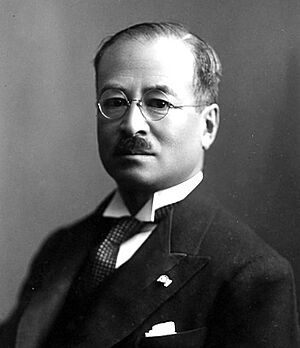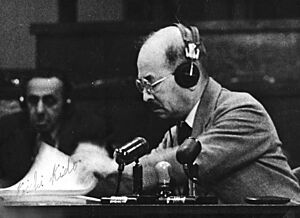Kōichi Kido facts for kids
Quick facts for kids
Marquess
Kōichi Kido
|
|
|---|---|
|
木戸 幸一
|
|

Kido in c. 1940
|
|
| Lord Keeper of the Privy Seal of Japan | |
| In office 1940–1945 |
|
| Monarch | Shōwa |
| Preceded by | Yuasa Kurahei |
| Succeeded by | Hisanori Fujita |
| Personal details | |
| Born | July 18, 1889 Akasaka, Tokyo, Japan |
| Died | April 6, 1977 (aged 87) Imperial Household Agency hospital, Tokyo, Japan |
| Cause of death | Cirrhosis |
| Resting place | Tama Cemetery, Tokyo, Japan |
| Spouse | Kodama Tsuruko |
| Relations | Kido Takayoshi (granduncle) |
| Children | 2 sons, 1 daughter |
| Parents |
|
| Alma mater | Kyoto Imperial University |
Kōichi Kido (born July 18, 1889 – died April 6, 1977) was an important Japanese leader. He served as the Lord Keeper of the Privy Seal of Japan from 1940 to 1945. This made him the closest advisor to Emperor Hirohito during World War II. After the war, he faced a trial and was sentenced to prison. He was released in 1953 after serving six years.
Contents
Kōichi Kido's Life Story
Early Years and Education
Kōichi Kido was born in Akasaka, Tokyo, on July 18, 1889. His father was Marquess Takamasa Kido, and his mother was Sueko Yamao. He was also the grand-nephew of Kido Takayoshi, a key figure in the Meiji Restoration. This was a time when Japan changed from a feudal society to a modern one.
Kido went to the Gakushuin Peer's School in Tokyo. After that, he studied law at Kyoto University. One of his professors there was the economist Hajime Kawakami. After finishing university in 1915, Kido started working in government. He held several jobs in the Ministry of Agriculture and Commerce. Later, he moved to the Ministry of Commerce and Industry.
In 1931, Kido helped create the Strategic Industries Control Act. This law gave the government more control over many industries. It was a step towards Japan's increasing military focus in the 1930s. In 1930, Kido became the chief secretary of the Home Ministry.
Political Career and Influence
Kido's political career grew when his friend Fumimaro Konoe became Prime Minister of Japan in 1937. Kido was then appointed Minister of Education. From January 1938, he also served as Minister of Health and Welfare. In January 1939, Kido became the Home Minister in the Hiranuma Cabinet.
In 1940, Kido became the Lord Keeper of the Privy Seal of Japan. This was a very important role. It made him one of Emperor Hirohito's most trusted advisors. He suggested that Konoe should become Prime Minister again. Kido also worked with Konoe to create the Taisei Yokusankai. This group aimed to replace all political parties with a single state-controlled organization.
In 1941, Kido suggested that Hideki Tōjō become Prime Minister. He believed Tōjō was one of the few who could control the more extreme parts of the Imperial Japanese Army. However, Kido was also a cautious advisor to Emperor Hirohito. At the start of World War II, he advised against attacking the Dutch East Indies. He warned that it could lead to war with the United States. He also said that any oil gained would be hard to transport safely.
After the war, Kido stated that Emperor Hirohito did not know about the plans to attack Pearl Harbor until after it happened. As the war went badly for Japan, Kido became a strong supporter of finding a way to make peace. Many believe he convinced the government to accept the Potsdam Declaration and surrender. He also persuaded the emperor to make a personal speech. This speech was important to ensure all Japanese people would stop fighting. Kido was a target during the Kyūjō Incident. This was an attempt to stop Japan's surrender in the final days of the war.
After the War

Kido was not only the emperor's main advisor. He also connected the emperor with the government. He represented Japan to the Allied Occupation Forces. He advised General MacArthur on many details about Japan's surrender and the end of the war. Kido's main goal was always to protect the emperor's honor.
After the war, Kido was charged with serious offenses related to the war. This happened at the International Military Tribunal for the Far East in Tokyo. He first tried to take all responsibility for the war decisions himself. He hoped this would protect the emperor. Kido's personal diary, which he had kept since 1930, was given to the court. It became an important record of how the Japanese government worked during the war. The court used it as evidence against many people, including Kido. He was found responsible for several charges and was sentenced to life in Sugamo Prison, Tokyo.
In 1951, as the Allied Occupation of Japan was ending, Kido sent a message to the emperor. He advised him to accept responsibility for Japan's defeat and step down. Kido also disagreed with punishing people under Japanese law after the American Occupation ended. He felt that those called "war criminals" by the enemy were doing their duty. He believed it would be wrong to punish them in the emperor's name.
In 1953, Kido was released from prison due to health problems. He lived the rest of his life in Oiso, Kanagawa Prefecture. He also had a home in Tokyo. Kido passed away at age 87 in 1977 at a hospital in Tokyo. His grave is at the Tama Cemetery in Tokyo. Kido was married to Kodama Tsuruko. They had two sons and one daughter.
Images for kids



